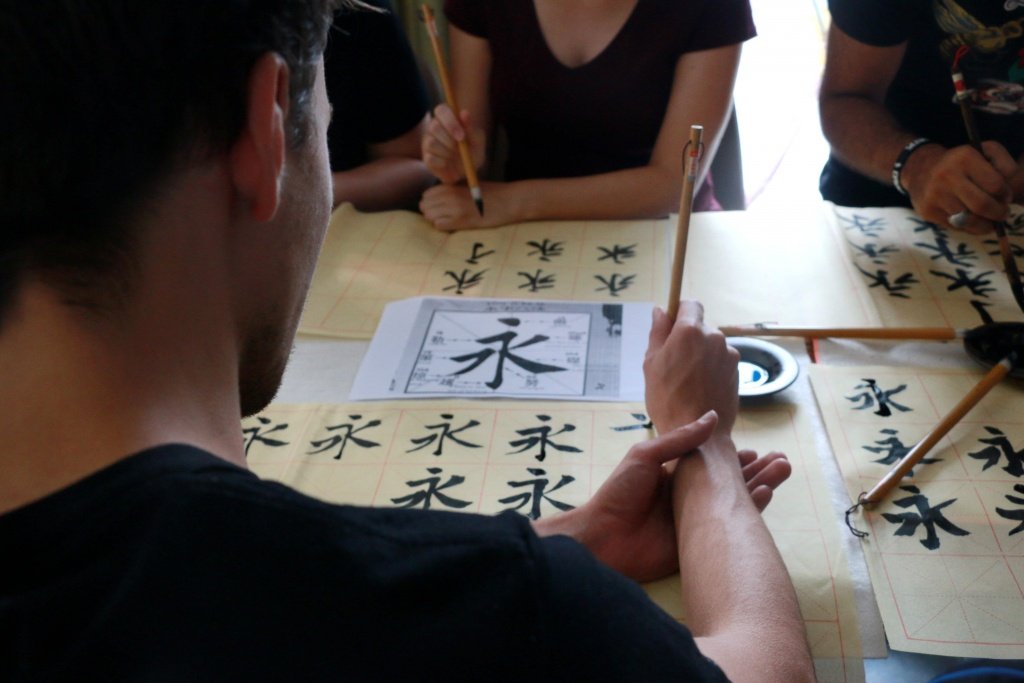Calligraphy in China holds a deep cultural and artistic significance, reflecting not only written communication but also the philosophical and aesthetic values of Chinese civilization. Unlike simple handwriting, Chinese calligraphy is a complex art form that has evolved over thousands of years, influenced by historical events, philosophical ideologies, and artistic movements.
Origins of Calligraphy in China
The origins of calligraphy in China can be traced back to the Shang Dynasty (c. 1600–1046 BCE), when early inscriptions were carved onto oracle bones. These inscriptions, known as oracle bone script, were used for divination and recorded important events. This early form of Chinese writing laid the foundation for the development of various calligraphic scripts over the centuries.
During the Zhou Dynasty (1046–256 BCE), calligraphy in China became more structured with the emergence of bronze inscriptions. These writings, cast onto bronze vessels, displayed more defined strokes and a standardized form. As the need for official documentation grew, early clerical scripts began to take shape, paving the way for more refined calligraphic styles.
The Development of Calligraphic Styles
Over time, calligraphy in China evolved into several distinct script styles, each with its own characteristics and historical context:
- Seal Script (篆书, Zhuànshū) – Used primarily for inscriptions on seals and official documents, seal script is one of the oldest forms of Chinese calligraphy. It is characterized by its uniform structure and symmetrical strokes.
- Clerical Script (隶书, Lìshū) – Developed during the Han Dynasty (206 BCE–220 CE), clerical script was widely used for official government records. This script introduced broader, flatter strokes, making it easier to write with a brush.
- Regular Script (楷书, Kǎishū) – Gaining popularity during the Eastern Jin Dynasty (266–420 CE), regular script remains one of the most widely practiced calligraphic styles today. It features balanced, well-defined strokes that emphasize clarity and precision.
- Running Script (行书, Xíngshū) – This semi-cursive style emerged during the Han Dynasty, offering a more fluid and expressive approach to writing. It allows for faster brush movements while maintaining readability.
- Cursive Script (草书, Cǎoshū) – Often regarded as the most artistic form of calligraphy in China, cursive script prioritizes expressive brushwork and fluidity. It is commonly used in artistic calligraphy rather than formal writing.
Calligraphy in China as an Art Form
Unlike in many cultures where handwriting is simply a functional skill, calligraphy in China is deeply rooted in artistic expression and personal cultivation. Each brushstroke reflects the writer’s emotions, thoughts, and energy, making it a form of visual poetry.
The act of writing calligraphy requires precision, patience, and a deep understanding of brush techniques. Artists study stroke order, ink flow, and paper texture to master the craft. Even small variations in brush pressure or speed can dramatically alter the outcome of a piece.
Philosophical and Cultural Significance
Calligraphy in China is closely linked to Confucian, Taoist, and Buddhist philosophies. Confucian scholars valued calligraphy as a means of cultivating discipline and moral integrity. Taoist influences emphasized spontaneity and harmony with nature, which can be seen in the flowing movements of certain calligraphic styles. Meanwhile, Buddhist monks often used calligraphy as a meditative practice, believing that each stroke could bring spiritual enlightenment.
Throughout Chinese history, calligraphy has been a crucial part of scholarly education. Imperial examinations required candidates to demonstrate their calligraphic skills, reinforcing the idea that mastery of writing was a mark of intellect and refinement.
The Influence of Calligraphy in Chinese Society
Calligraphy in China extends beyond artistic expression and has played a significant role in shaping various aspects of society:
- Literature and Poetry – Many famous Chinese poets were also skilled calligraphers, using their brushwork to enhance the emotional impact of their verses.
- Painting and Art – Traditional Chinese painting often incorporates calligraphy, blending visual and literary elements into a harmonious composition.
- Ceremony and Tradition – Calligraphy is commonly used in festive decorations, wedding invitations, and religious texts, symbolizing prosperity and cultural heritage.
Calligraphy Education and Practice
Even in modern times, calligraphy in China remains an essential part of artistic and cultural education. Many schools teach students the fundamentals of brush writing, emphasizing the importance of patience and practice. Calligraphy contests and exhibitions are held regularly, showcasing the works of both traditional and contemporary artists.
Practicing calligraphy requires specialized tools, including:
- Brush (毛笔, Máobǐ) – The primary instrument used in Chinese calligraphy, available in various sizes and materials.
- Ink (墨, Mò) – Traditionally made from soot and animal glue, ink is ground on an inkstone and mixed with water.
- Paper (纸, Zhǐ) – Also known as Xuan paper, this highly absorbent material enhances the fluidity of brushstrokes.
- Inkstone (砚, Yàn) – Used to grind and mix ink, ensuring a smooth application during writing.
Modern Influence and Global Recognition
Despite technological advancements, calligraphy in China continues to thrive in the modern era. Digital calligraphy, virtual exhibitions, and online tutorials have made the art form more accessible to people worldwide. Many artists experiment with contemporary styles, blending traditional techniques with modern artistic influences.
Calligraphy has also gained recognition beyond China, influencing artistic traditions in Japan, Korea, and Vietnam. Museums, galleries, and cultural institutions around the world showcase Chinese calligraphy, highlighting its historical and aesthetic significance.
Conclusion
The transformation of calligraphy in China from a simple writing system to a highly respected art form reflects the depth of Chinese culture and philosophy. More than just words on paper, calligraphy embodies artistic mastery, spiritual discipline, and cultural heritage. Whether through classical scripts or modern interpretations, the tradition of Chinese calligraphy continues to inspire generations, preserving an art form that has shaped Chinese identity for thousands of years.



